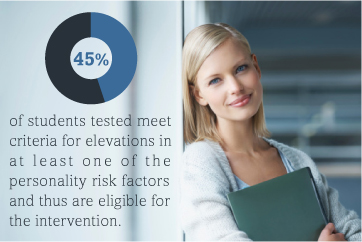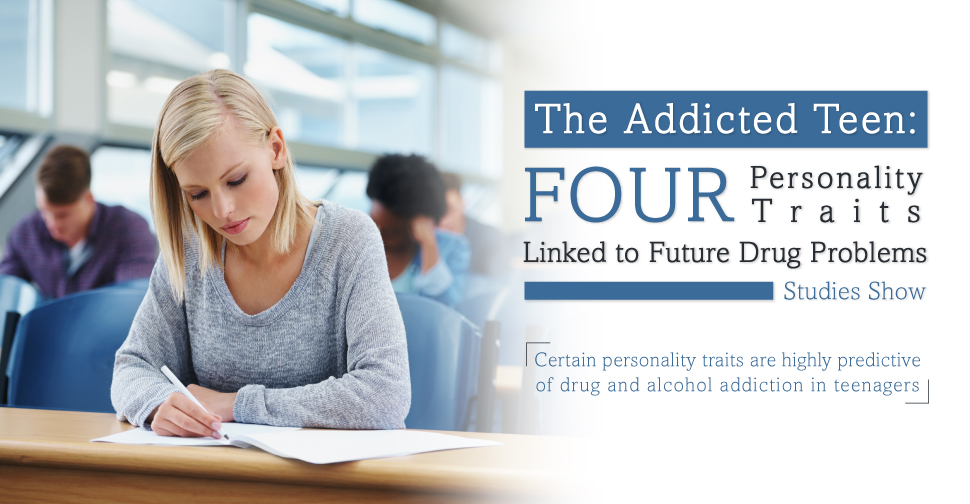Certain personality traits are highly predictive of drug and alcohol addiction in teenagers, according to a growing body of research. The findings have inspired the first intervention to target the temperaments of high-risk youth – helping them delay or prevent drug use by learning how to manage vulnerable personality styles.
Researchers at the University of Montreal have identified four personality risk factors that are associated with adolescent drug and alcohol abuse:
- Anxiety Sensitivity
- Hopelessness
- Impulsivity
- Sensation-seeking
These insights could describe the high school honor student who has no conduct issues, but uses drugs to cope with crippling anxiety. Or the teen who turns to opiate painkillers to escape feelings of failure and depression.
Impulsiveness – a trait often associated with Attention Deficit Hyperactivity Disorder (ADHD) – may spur a child to use cocaine or other stimulants, without thinking of the consequences. And even if they are immune to peer pressure, teens identified as sensation/thrill seekers are more prone to binge drinking and alcohol dependence, the studies reveal.
“We were able to show in longitudinal research with youth that personality is a risk factor for escalations in substance use,” says Sherry Stewart, Ph.D., a professor of psychiatry, psychology, and community health and epidemiology at Dalhousie University in Nova Scotia, Canada.
Teens with high-risk personality profiles may be drawn to particular drugs that meet short-term needs, Stewart notes. “For example, anxiety-sensitive young people get into trouble because they use substances for risky reasons like managing their anxiety or trying to fit in with their peers,” Stewart notes. “Personality-targeted interventions provide young people with coping skills for better managing their personality vulnerability and thereby reduce their risk for substance use/misuse.”
Keeping Kids Safe: A Jump Start
Stewart helped create the Substance Use Risk Profile Scale (SURPS), which can identify up to 91 percent of children at high risk for future drug and alcohol problems. The self-report questionnaire is being used in a new intervention known as “Preventure,” the first anti-drug program to target personality traits.
Developed by fellow Canadian researcher Patricia Conrod, Ph.D., a professor of psychiatry at the University of Montreal, Preventure has been tested in thousands of adolescents in Canada, Australia and Europe (funding is being explored to bring Preventure to the United States).
The results of eight randomized trials are encouraging.
A two-year study of nearly 2,700 British ninth graders showed that Preventure cut the odds of binge drinking significantly – by 43 percent – among those teens at high risk for addiction.
Preventure also reduced the odds of overall drinking by 29 percent (whether a student was at high risk for addiction or not) and delayed a progression to more severe drinking patterns. (“Effectiveness of a Selective, Personality-Targeted Prevention Program for Adolescent Alcohol Use and Misuse,” Patricia J. Conrod; published in JAMA Psychiatry, 2013).
In Australia, 438 high-risk teens participated in a Preventure trial conducted at 14 high schools between 2012 and 2015. Compared to a control group, the Preventure teens had a significant reduction in alcohol use, binge drinking, and alcohol-related harm (“The long-term effectiveness of a selective, personality-targeted prevention program in reducing alcohol use and related harms: A cluster randomised controlled trial,” Newton N.C., Conrod, P., et. al., Journal of Child Psychology and Psychiatry, 2016).
As a personality-based intervention, Preventure has also been shown to delay the onset or severity of mental health problems – including depression and panic attacks. The program reduced truancy in teens who completed training for anxiety-sensitive traits, and cut shoplifting rates among youth attending workshops that targeted high impulsivity (“Brief interventions targeting personality risk factors for adolescent substance misuse reduce depression, panic and risk-taking behaviours,” Natalie Castellanos & Patricia Conrod; Journal of Mental Health, 2009).
Similar findings of reduced depression, anxiety and conduct symptoms were noted in a Preventure trial of 1,024 London adolescents in 2013.
“We have shown that we can achieve reductions in symptoms of these mental health problems and other risk-taking behaviors with the Preventure program,” Stewart says. “The anxiety-sensitivity intervention reduces panic, the hopelessness intervention reduces depression, the impulsivity intervention reduces behaviors like shoplifting.”
The largest Preventure trial is nearing completion at 31 high schools in Quebec, and will evaluate the program’s impact on mental health outcomes, Stewart says.
Managing Their Risk:
How Preventure Helps Teens Handle Extreme Personality Traits
 Preventure starts with the 23-item SURPS questionnaire, which identifies teens with high-risk personality profiles (anxiety-sensitivity, hopelessness, impulsivity, sensation-seeking).
Preventure starts with the 23-item SURPS questionnaire, which identifies teens with high-risk personality profiles (anxiety-sensitivity, hopelessness, impulsivity, sensation-seeking).
“When we do a school-wide screening, about 45 percent of students tested meet criteria for elevations in at least one of the personality risk factors – and thus are eligible for the intervention,” Stewart says.
High-risk youth are invited to attend two 90-minute workshops with students who share similar personality profiles. These targeted group sessions, led by specially trained teachers or mental health practitioners, apply the principles of Cognitive Behavioral Therapy (CBT) and motivational approaches to deter substance use.
Students examine how their specific personality traits can lead to risky behaviors, and why faulty thinking patterns may contribute to drug use and mental health issues. A child with anxiety sensitivity, for example, may worry that a racing heart means an impending heart attack, or that a lack of concentration means they are “going crazy,” Stewart says. When they get nervous, anxiety-sensitive teens may believe others will notice and reject them.
Preventure helps these students “get more accurate information on the anxiety response, learn to identify and challenge their tendency to predict the worst and to catastrophize about the meaning of physical sensations,” Stewart says.
High-risk teens consider how their typical emotional and behavioral reactions hinder their personal goals. They learn new coping skills to manage their personality traits and are encouraged to approach, rather than avoid, anxiety-provoking situations, Stewart says.

“By learning not to fear their anxiety-related sensations, they have a lessened need to use substances to manage their anxiety, or to fit in with peers,” she notes.
Using evidence-based CBT, Preventure shows teens who feel hopeless how to squash negative self-talk. Impulsive youth learn how to manage their tendency to act quickly for immediate rewards without thinking about consequences. As seen in the research trials, this intervention has been shown to reduce drug use and other risky behaviors such as shoplifting.
“For the sensation seekers, we help them find alternative, safer ways of meeting their need for excitement than through drug use,” Stewart adds.
To ensure accurate self-reporting, the Preventure screening is confidential, and the program uses separate staff for the screenings vs. the interventions (so that teens won’t exaggerate gains in order to please a therapist). “And we will include a fake “drug” in the list of drugs we ask about, to detect those who may be exaggerating their substance use,” Stewart says.
A Critical Time for Brain Development
While Preventure could improve the trajectory for teens at risk of addiction, the majority of young people do not develop drug or alcohol problems, research shows.
An estimated 2.2 million American adolescents (ages 12 to 17) are current users of illicit drugs which represents 8.8 percent of the adolescent population, according to the 2015 National Survey on Drug Use and Health.
Alcohol is the substance most widely used by adolescents, followed by marijuana. About 2.4 million adolescents, or 9.6 percent of that population, say they are current alcohol users, and binge drinking is reported by 1.4 million adolescents (5.8 percent of people ages 12 to 17).
Like tobacco use, alcohol consumption has notably declined among the nation’s youth over the past two decades. That’s the evidence from the Monitoring the Future report, an annual survey of nearly 45,000 students in grades 8, 10 and 12. Illicit drug use among these age groups was down slightly in 2015, according to the report, which is funded by the National Institute on Drug Abuse.

Despite these promising trends, experts say adolescence is a crucial time for brain growth and remains the period of highest risk for the onset of future drug and alcohol problems.
In other words, drug abuse can interfere with normal development of the teenage brain. And that puts a young person at higher risk for a substance use disorder.
“Adolescents are more vulnerable to alcohol and other drugs than adults because the parts of the brain responsible for judgment, decision making, emotion and impulse control are not yet fully developed,” says Amy Schreiner, Ph.D., associate research scientist and project director at the National Center on Addiction and Substance Abuse at Columbia University. “This developmental process will not be complete until the mid-20s and makes teens more likely than adults to take risks such as experimenting with nicotine, alcohol or other drugs.”

Indeed, teens are taking risks with addictive substances. Nearly half of high school seniors report having been drunk at least once in their life; 24 percent took illicit drugs in the past month; and two out of three students have consumed alcohol by the end of high school, according to the 2015 Monitoring the Future survey.
As they enter young adulthood (ages 18-25), the fallout is more dangerous. Young adults have the highest rate of substance use disorders, and report an alarming amount of binge drinking –involving 39 percent of the population ages 18-25.
Each year, more than 1,800 college students die from alcohol-related causes, according to the National Institute on Alcohol Abuse and Alcoholism (NIAAA). Heavy drinking also contributes to sexual assaults and other injuries, and jeopardizes academic performance, research shows.
Early intervention, such as the personality-based Preventure program, could shatter these trends by helping high-risk adolescents.
“There is definitely a benefit to implementing effective interventions that target youth with known risk factors as a part of broader prevention efforts,” Schreiner says. She notes multiple personal characteristics and life circumstances that put teens at risk for substance use – including genetic predisposition; family history of substance misuse or addiction; childhood abuse, neglect or trauma; mental health disorders; certain temperament traits and low self-esteem; bullying and poor academic performance.
“Research is continuing to shed light on ways risk factors interact with each other and the environment,” Schreiner says. “This work will help inform the most effective means to identify and target at-risk teens.”



